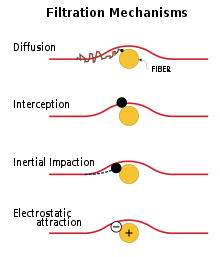.
But what does that really mean and how do they work?
The U.S. Department of Energy first termed HEPA as a filtering specification for suppliers of filtration products based on how effective they were at particle removal.
HEPA filters consist of a complicated mix of filaments and fibers that carry a static charge which lures various microbes and particles like a magnet.
While the particles travel through the air filtration system, they’re captured and retained within the filter. Additionally, an interesting scientific effect occurs known as Brownian Motion which causes particles in certain media states (such as fluid) to bounce around and become trapped.

How do N95 or KN95 face masks compare to HEPA air purifiers?
You may see or hear about people wearing surgical masks or N95 or KN95 rated masks to prevent themselves and others from being exposed to Covid-19. One important thing to note is that these masks are not as effective as HEPA air purifier systems like the Vaniman Pure Breeze which is more efficient than KN95/N95.
N95 or KN95 face masks capture 95% of particles down to 0.3 micron. This means that 5% still get through the protection. HEPA air purifiers in contrast are 99.97% effective at 0.3 Micron and are much more efficient than face masks.
What is the difference between MERV and HEPA filters?
You may have heard the term “MERV” before. It stands for Minimum Efficiency Reporting Value and is a rating system for HVAC air filters created by the American Society of Heating, Refrigerating, and Air Conditioning Engineers or (ASHRAE).
Many people are asking the question, “can I use a MERV filter in a mask”?
While there have been no scientific studies we could find for this, the answer is likely no.
Here’s why…
MERV stands for Minimum Efficiency Reporting Values, or MERVs, report a filter’s ability to capture larger particles between 0.3 and 10 microns (µm). (Per the EPA)
HEPA and MERV filters are usually not the same. MERV rated filters are typically used in air conditioning systems, including systems found in most homes.
MERV filters have a rating system… MERV 7, 8, 10, and so on—up to MERV 20.
MERV filters are not effective at filtering microbes and viruses until they are rated at 17 or better.
At these ratings, these are considered HEPA or ULPA rated and are effective, however you likely won’t see the MERV rating in these applications as they would simply state “HEPA” instead.
What is the difference between N95 and KN95 face masks?
N95 face masks are examples of personal protective equipment, or PPE, that are used to protect the wearer from airborne particles and liquid contaminating the face.
They are regulated by the FDA and NIOSH (U.S. National Institute for Occupational Safety and Health). The N is for “Not resistant to oil” and the 95 refers to the minimal is efficiency level at 0.3 microns (of which is it 95% efficient).
Similarly, KN95 masks are also a form of PPE used to protect the wearer from similar hazards though they are not regulated by NIOSH. These masks are often identical to N95 masks and are the “N95 equivalent” for medical usage in China.
In the US, they are primarily used in industrial settings and offer the same filtration as N95 face masks with a rating of 95% at 0.3 Micron. In fact, these masks are often produced from the same assembly line as N95 masks however are not sent for NIOSH regulation.
On April 3rd of this year, the FDA approved the use of KN95 masks for healthcare professionals in an effort to increase the available PPE face masks and lower the spread of the COVID-19.
View our KN95 Face Masks by clicking HERE.
How do viruses like COVID-19 spread through the air?
By nature, viruses are sub-micron in size-we’re talking 500nm (0.5 micron) and below. Not to mention viruses only require a small amount to enter your body in order to start an infection.



